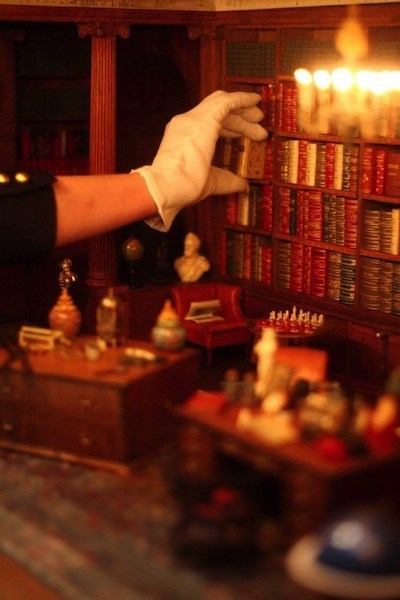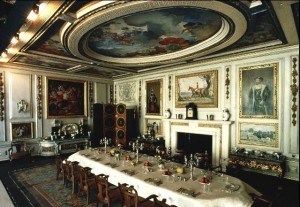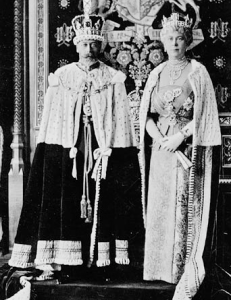Queen Mary’s Dolls House – In The Beginning
Queen Mary, wife of King George V. was an obsessive collector of ‘tiny craft.’She especially liked objects that had a connection to the Royal family. By her late 40s, the Queen had amassed a valuable collection of miniature items.
Princess Marie Louise, George V’s cousin, and Queen Victoria’s granddaughter was at an “at home” one Sunday afternoon at the height of the social season. Another party-goer was Edwin Lutyens, a leading architect of the day. The Princess later claimed that ‘on the impulse of the moment’ she mentioned that it would be nice if the Queen had some sort of large cabinet for all her diminutive treasures.
The Princess and the Architect
They met again at the Royal Academy Summer Exhibition of 1921. As much of the Queen’s collection involved dolls, they agreed that rather than an over-sized curio cabinet, a dolls house might be more appropriate. And so it began.
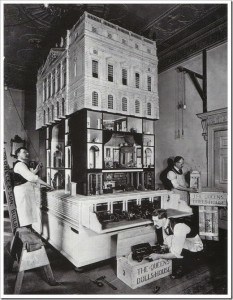
Moving men packing up the Queen Mary’s Dolls’ House in Sir Edwin Lutyens’ drawing room for delivery to the British Empire Exhibition at Wembley – September 2, 1924
Lutyens had been in charge of creating the eighty-square-mile planned city of New Delhi, India, for the past nine years. He told friends that it would give him great pleasure to also be applying himself to a dolls house standing 5 feet high, which was the proposed height in the initial drawings. Over time the dolls house grew to 9 feet tall. When it was time to deliver it to the Exposition at Wembley Park, Lutyens had to knock down one wall of his drawing room, where part of the construction had taken place.
Dollyleuyah Dinners
The creative process involved hundreds of people. Lutyens regularly began to hold what he called ‘Dollyleuyah Dinners’, which would lead to more than 1,500 individuals being recruited in the Dolls’ House construction: 250 craftsmen and manufacturers, 60 artist-decorators and 700 artists, 600 writers and 500 donors.
The Search For Inspiration
The Empire was scoured for examples to use as a starting point for the design. Lutyens seems to have been intrigued by the Uppark dolls house as a framework.
High Ceilings …
The Dolls House had lofty royal chambers with mezzanines. Every room had a window, either casement or with real sliding sashes. From the outside, what initially appears to be a podium supporting the house, is actually the basement quarters. Let down rusticated stone flaps at one end and the water tank and machinery for the elevators is revealed. At the other end of the narrow side, we see the wine cellar and food stores.
And Great Cars
On the front and back of the building are 2 large flaps. Lower the one in the rear and you can pull out a drawer exposing a five-bay garage housing a fleet of royal limousines supplied by Daimler, Sunbeam, Vauxhall, Lanchester, and Rolls-Royce. There’s even a Rudge motorbike with sidecar. The engines all work, and they have their own gas pump.
The flap in front conceals a drawer containing a garden designed by Gertrude Jekyll.
The Debut
In 1922 the British Empire Exhibition of Arts and Manufacturing, conceived to boost the spirits of the British subjects after the devastating war, and to stimulate trade, was given the go-ahead. To everyone’s surprise, this tiny masterpiece of an English house, displaying the very best that the United Kingdom could offer, would become its centerpiece. The Dolls House might have become a mere plaything, a toy to be added to the Royal Collection as a historical document on how a royal family might have lived during that period. Instead, it was to become a beacon of national importance.
An Icon
Queen Mary’s Dolls House become much more than a remarkable model of the everyday life of the wealthy in the early 1920s. These were the years of post-war convalescence when the largely unemployed nation needed help to stand on its feet again.
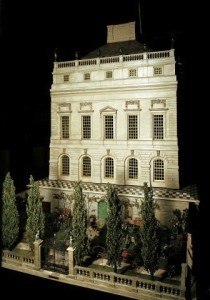
Queen Mary’s Dolls House, facade with garden drawer pulled out. Found on the Royal Collection website.
One reason the dolls house may have attained near mythic proportions was the adoration the British public felt for Queen Mary. Her indomitable spirit seemed to keep the Empire afloat during and after the First World War, particularly when her husband’s health began to fail. It ultimately became viewed as such by her loyal subjects.
There are many fine videos on the Dolls House, but I think the bit in the middle of a BBC series hosted by Fiona Bruce is the best. This episode is the second on Windsor Castle. The Dolls House segment begins at 17 minutes from the beginning of the video, starting with a black and white photo of George V and Queen Mary. It goes on for 5 minutes and has the best shots of the garden I have seen.
Click here to see a wonderful Ileana Ottini video of Queen Mary’s Dolls House.
Enjoy!
Susan Downing, with Patrick Owens
_________________________________________________________________________
I invite you to visit my Etsy Shop where I offer many accessories and pieces of furniture in 1:12 scale.


